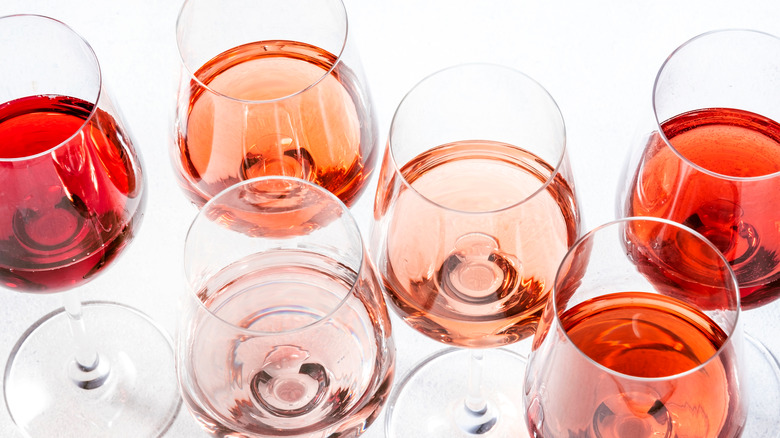The Process To Look For When Buying Non-Alcoholic Wines
Wine without alcohol isn't just grape juice. Far from one-dimensional, these wines can be just as delicious as they are intriguing. With so many domestic and international non-alcoholic brands like Fre, Töst, Ariel, Noughty, Leitz, and Proxies, there's no shortage of options. However, since not all NA wines are created equal, there are a few things that novice non-alcoholic wine drinkers should look for when buying — especially when it comes to how the wine is made.
Following the trend for booze-free tipples, NielsenIQ reports that the NA wine industry has increased revenue by 23% in the last year, translating into over $52 million in sales. Among the many reasons to imbibe sans alcohol, NPR explains that the sober revolution is fuelled mainly by youthful drinkers also interested in well-being. Rather than opt for juices or mocktails, alcohol-free wines are bottled and served like traditional vino, delivering the same experience. But what exactly can abstaining oenophiles expect in their glass?
Zero-alcohol wines often taste different because of how they're made. While some proxies are simply grape juice layered with other ingredients, Advanced Mixology states that others undergo de-alcoholization. During the process of removing alcohol — through vacuum distillation, reverse osmosis, spinning cone column, or thermal gradient processing (via The Institute of Food Technologists) — there's also removal of flavor, aroma, and textural components. This gives NA wines a different structure and mouthfeel, which winemakers must correct. Not sure where to start?
De-alcoholized wines have a similar taste to the real thing
According to Decanter, only wines labeled "de-alcoholized" go through the fermentation and vinification process. Made with a traditional wine base (unlike certain "low alcohol" or "alcohol-free" wine-based beverages), they impart a similar flavor profile. Consequently, this is why Liquor.com suggests opting for bottles labeled "de-alcoholized" or "alcohol-removed" as an approachable foray into NA wine. Just note that due to undergoing a process of fermentation, these wines will still contain trace amounts of alcohol, around 0.5% ABV.
As for what to shop for, finding a favorable variety is mainly based on trial and error. Researching producers, alcohol content, and flavor profile is a good place to start. However, if you're totally at a loss on where to begin, Imbibe recommends trying something sparkling as its bubbly quality can mimic the mouthfeel of alcohol.
Given that NA wines are still growing in popularity, accessibility can be limited, making the best option to buy wines from online retailers like No & Low or The Zero Proof Bottle Shop or even stop by spots such as Boisson in New York, Sipple in Houston, or Soft Spirits in Los Angeles, shares Master of Mocktails.
Of course, once you find a bottle, the next hurdle is figuring out how to best enjoy it. According to Danny Frounfelkner, the owner of Sipple, non-alcoholic white, rosé, and sparkling wines can be paired with foods like their alcoholic counterparts; however, you should approach any NA red wine as if it were "a light-to-medium bodied dry Italian wine" (via Wine Enthusiast). Break out the glasses, and get tasting!

